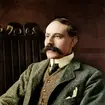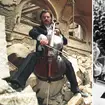Julian Lloyd Webber Gets To The Heart Of Elgar
“I’ll never forget the moment,” he says. “I’d just played the Three Choirs Festival – one of my first big concerts after leaving college. I was walking back after a couple of beers in a little pub down there [he points] and heard Elgar’s swelling choral music from the cathedral. It was absolutely wonderful.”
Julian Lloyd Webber is gesturing with the hands that so fluidly conjure melodies from his 300-year-old Stradivarius cello.
Well before that memorable night, Elgar’s music and the verdant hills of the composer’s home were already exerting a pull on the teenage Julian.
“In the late 1960s I started taking my father’s Mini and heading out west from London towards this part of the world,” he remembers. Now he’s driving west once more, but with a vehicle that’s just a little more comfortable, spacious and powerful than his dad’s car: a 6.7-litre Rolls Royce Phantom.
The cellist’s favourite drive begins at the pink-hued Hereford Cathedral, its Romanesque stones girdled in soft morning light. Julian has a particular affinity with the city, not only because of the personal memories it holds, but also for its links with Elgar, whose music the cellist so vividly brings to life.
The composer wrote some of his greatest scores – including his First Symphony and the Violin Concerto – while living in Hereford, and was closely involved with the Three Choirs Festival.
The silver car raises onlookers’ eyebrows, and one or two false hopes, as it purrs to a halt outside its first stop – Hereford United’s football ground.
“There hasn’t been a Rolls here since Hereford beat Newcastle in 1972,” Julian observes dryly. “They think I’m going to buy the club – that I’m their Roman Abramovitch.”
Hereford United is Julian’s secret vice, a love that barely dares speak its name for the lifelong Leyton Orient supporter.
“It started when I was travelling round here,” he confesses. “And it took off when Hereford went out of the league – I have a thing about supporting underdogs. It was still painful when I saw them beat Orient though.”
With his head full of the unlikely hope that Hereford will buy a couple of Brazilian strikers, Julian drives off down the gnarly old roads.
“Elgar lived just down there,” he points out, as he navigates his way round the throngs of morning shoppers. As we hit open country, right on cue as if counted in by a conductor’s baton, the cloudy sky fragments to reveal bright sunshine.
Our target, a few miles southeast, is Mordiford. The middle-aged Elgar loved to cycle across the medieval bridge over the meandering River Lugg, where he’d sketch, fish and wait for inspiration. Despite an increase in traffic it’s still truly lovely, with trees bending to kiss the dark waters as the spine of the Malvern Hills arches in the distance.
“Elgar’s music was highly influenced by local scenery,” says Julian. “It rises and falls like the landscape. He was born and did most of his work within sight of the Malvern Hills. They would have been the first thing he saw from his bedroom window when he woke up in the morning – his very first memory.”
“Elgar used to say: ‘Music is in the air and all around us. You just take as much as you want’. When you’re here, in the Malverns, you can see and feel what he meant. It’s a huge advantage to a performer interpreting his work to actually visit here.”
As we press on, passing Ledbury’s solid brick houses and wattle-and-timber walls, bulging with age and dripping with flowers, Julian turns the silver lady up into the hills. It’s the ideal moment for the cellist to reveal his favourite road music.
“The best driving music is Elgar’s First Symphony,” he says. “It feels absolutely right to listen to it as you motor around here – a natural extension of where you are. Some music transfers you to a different time or place, but this piece seems to flow from the countryside – not just its summer sweetness, but also its winter bleakness. It sums up so much about Elgar. It’s very complex – amazing when you think he was self-taught.”
It helps that we’re engulfed by the Phantom’s superlative sound system. “Listening to the music now you wouldn’t know you were driving; the car’s so soundproof,” Julian comments. “It’s crystal clear and doesn’t distort at any level. I’m impressed.”
He’s similarly impressed by Little Malvern Priory, a former Benedictine monastery backed by steeply rising forested hills, which Julian stumbled across on a previous visit. It’s a short distance from Elgar’s grave in St Wulstan’s Church. However, the cellist plans to make Little Malvern his own final resting place.
“Elgar’s buried nearby but I think this is so much better. It has gorgeous views across the Malverns and ahead to the Cotswolds. On a clear day you can probably see for 30 or 40 miles. When I discovered it, I thought, ‘This is it. A good, peaceful spot for the end of one’s days’.”
His final destination gives the cellist the chance to put the Rolls Royce through its paces: down one side of the Malverns, back through Hereford and on towards Brecon and Wales. Rushing to catch final lunch orders at a local pub we slip past ambling rural traffic.
“God it’s good,” he observes, as the car shimmies round a Porsche. “It must have quite an engine to shift this much metal so fast. I love the kick around 70mph – better than the Mini!”
We pass the chequered flag just in time for food – local lamb shank and Herefordshire cider – at Rhydspence Inn. The 14th-century timber-framed pub lies within a leek’s toss of the Welsh border.
“I found it years ago by chance,” says Julian. “It’s a useful pitstop if you’re heading from northern England to south Wales.”
As we return to Castle House, an elegant Georgian hotel tucked into Hereford’s cathedral quarter where Julian is staying, the cellist is totally at ease with the three-tonne Phantom.
“I’ve never driven anything this long,” he says. “I feared it might be cumbersome, but it handles so well. It’s like when I first played my Stradivarius – I was frightened of it because of what it was. But after a while it just becomes your cello. It’s the same with this car.”

























